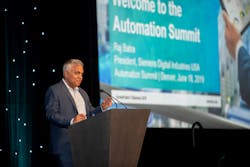Siemens’ Plan for Thriving Amid Industry Disruption
“It’s a time of disruption across industry,” said Raj Batra, president of Siemens Digital Industries USA, during his presentation at the Siemens 2019 Automation Summit. The disruption he referenced relates not just to the rapid advances being made to industrial automation technologies and their impacts on industry, but also to the changing business dynamics surrounding customer demands for more customization and the shifting geopolitical realties of worldwide supply chain operations.
“Everyone [in industry] needs more flexibility to deal with mass customization,” Batra said. As examples, he cited the chemical industry’s need for flexibility to address local production strategies, the aerospace industry’s need to better address time-to-market in light of their historically lengthy seven-year production backlogs, and the machine building industry’s need to provide improved productivity by reducing commissioning time.
Batra explained that Siemens has been focused on addressing each of these issues—and others associated with industry’s digital transformation—through its acquisition and R&D strategies for more than a decade. “You can’t get there [providing the digital technologies and services industries need] in a bolt-on way through pure acquisition,” he said, highlighting how Siemens has increased its $4 billion R&D spend in 2014 to a projected $5.7 billion spend in 2019. “That’s a 40 percent increase in R&D spending in addition to the more than $10 billion we’ve spent in mergers and acquisitions since 2007.”
The most recent effect of Siemens’ acquisitions and “organic R&D” strategy was announced on April 1, 2019, with the launch of Siemens Digital Industries. This new organization of Siemens business units combines technologies associated with factory automation, motion control, processing, and software platforms and applications with Siemens customer services to deliver vertical solutions across the discrete, hybrid, and process industries, Batra said. He noted that Siemens Digital Industries has 75,000 employees located globally with, currently, 16.3 billion euros in orders and 15.6 billion euros in revenue.
“The foundation of Siemens Digital Industries is based on the integration of the virtual and real worlds of industry and it has driven our work in software development over the past decade toward delivering the digital twin,” said Batra. He explained that Siemens vision of the digital twin encompasses product, performance, and production process across industry verticals.
Batra added that Siemens’ own application of the digital twin has delivered a 30 percent reduction in design engineering time and 50 percent reduction in time to market for its products.
The key to achieving these levels of improvement with the digital twin is having a common digital repository for all your data, Batra said.
One example of the results Siemens is delivering for its customers through its digitalization technologies was highlighted in a presentation about Air Products and Chemicals' deployment of its ProcessMD application on the Siemens Mindsphere IoT platform. ProcessMD is a web-based predictive monitoring and fault diagnostics platform using advanced statistical models to adjust for variables like ambient temperature and production rate to determine when a key process variable is out of range. These models enable ProcessMD to provide advanced warnings to engineers and operators about pending issues related to fixed alarms that are often set at much higher levels before issuing alerts.
By connecting ProcessMD with Mindsphere, Air Products is extending its business services model to deploy ProcessMD at customer sites. This allows Air Products engineers to assess their customers’ equipment data and provide the type of advanced notice of maintenance and repair requirements that Air Products has previously only used internally.
About the Author
David Greenfield, editor in chief
Editor in Chief

Leaders relevant to this article:
